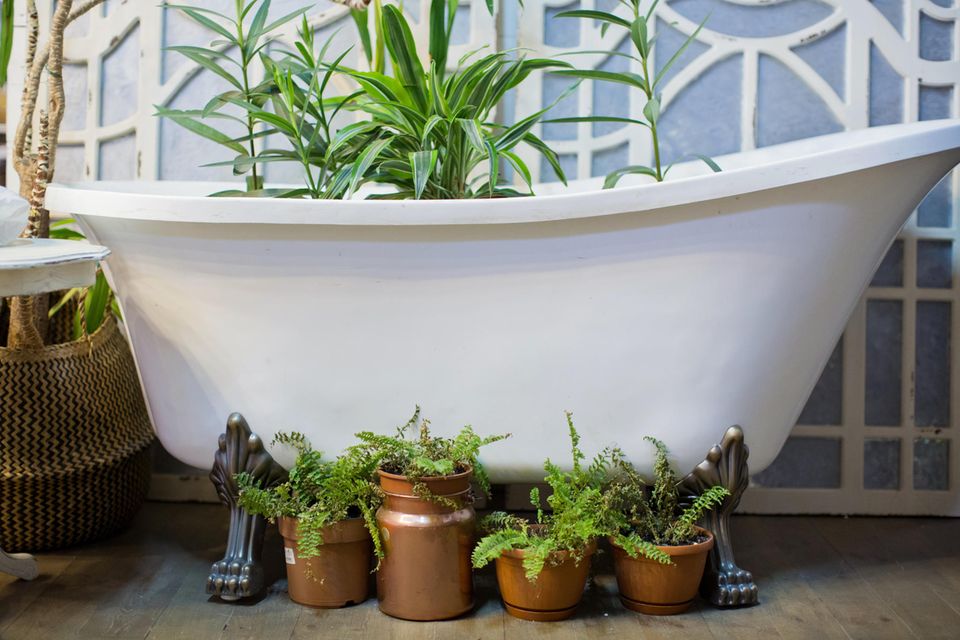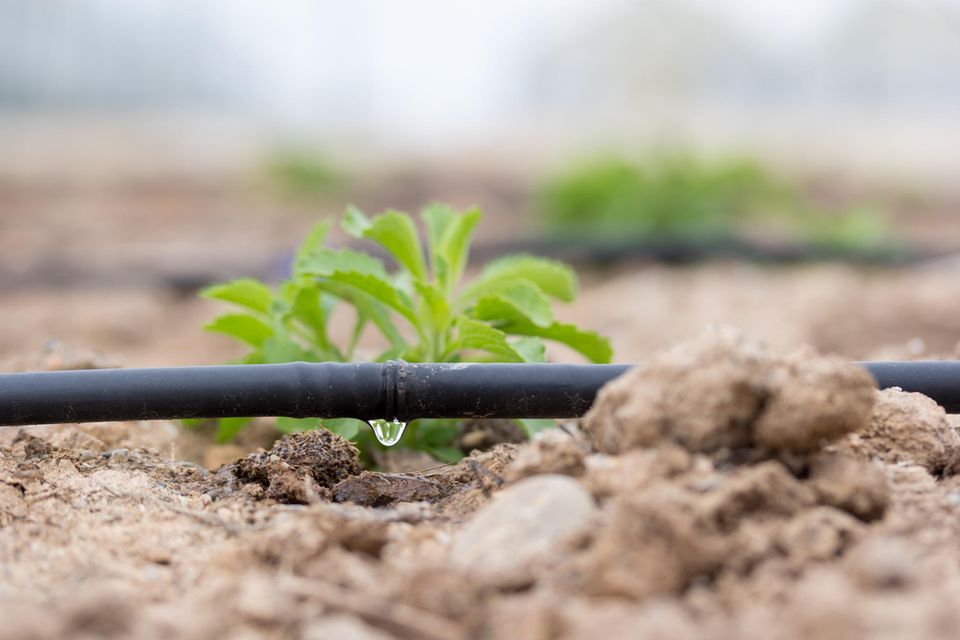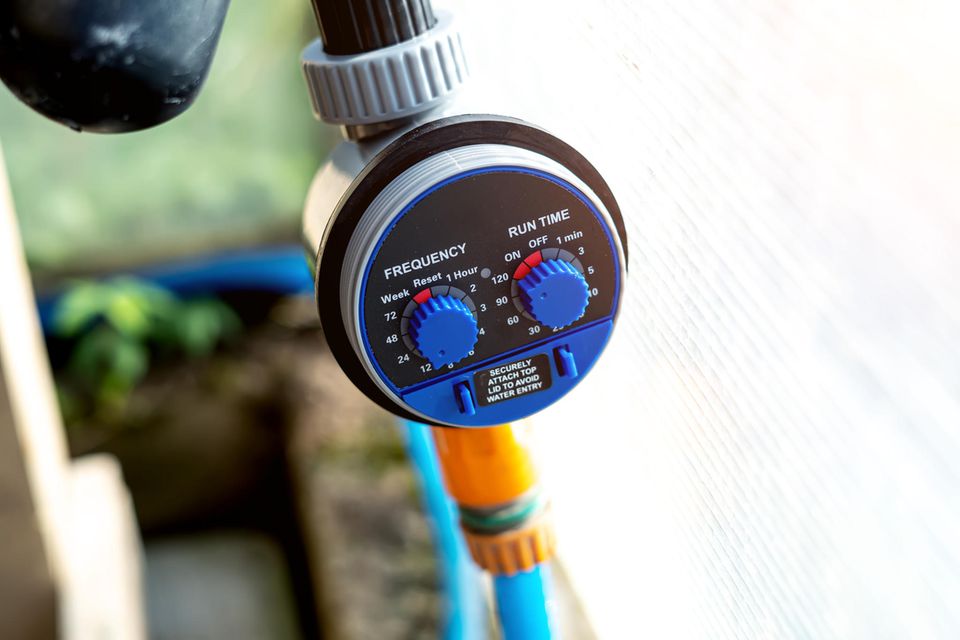When plant owners go on summer vacation and have to leave their beloved greenery behind, many plants are at risk of drying out. Even the most robust plant cannot withstand two weeks without water - especially not in summer temperatures. If there are no neighbors around, an irrigation system is needed! What makes sense and what tools are there? We present different techniques for watering plants and gardens.
Classic: the PET bottle trick
You probably already have the material you need for this irrigation technique at home. All you need are empty PET bottles with lids, scissors or a knife, and a drill. First of all, the soil of the plants is properly pre-watered – otherwise you run the risk that the plant will immediately draw a large amount of water as soon as the filled PET bottles are placed in the soil.

Then drill a few small holes in the bottle cap, fill the bottle with water, screw the lid back on and insert the bottle into the flower pot or window box with the lid facing down. Since this principle works through a vacuum – the bottle contracts slowly while the water is pulled out – thin-walled bottles are particularly suitable. This makes it easier for the plant to get to the water.
An alternative is special irrigation attachments. These save drilling holes in the lid. With a sharp knife, the bottom of the bottle is cut off to a piece of about one centimeter. Then the watering attachment is mounted on the bottle instead of the lid, the desired amount of drip is set and placed in the plant's tub. Then just fill in the water and put the bottom of the bottle back on so that no insects fly into the bottle and interfere with the watering.
irrigation attachments for PET bottles, for example from Fostoy or as a Set of 12 by Cherioll. These have the advantage that the amount of water dispensed can be adjusted individually for each plant.
It doesn't take much: the watering cord
A similar method for watering plants in small pots up to about 20 centimeters in diameter is the watering cord. To do this, you will need a wool thread, an empty PET bottle and scissors.
First, the top end of the plastic bottle is cut off and the remaining part of the bottle is filled with water. Then the wool thread is used. This is watered heavily until it is completely soaked with water. Then place one end in the open bottle and bury the other end in the flower pot near the plant root to about half the depth of the pot. When the soil in the pot becomes dry, it automatically "sucks" water out of the storage tank via the damp wool thread.
Attention: For the homemade irrigation system to work properly, the watering cord must be made of real cotton or sheep's wool so that the water is passed on. Conventional balls of wool are often made of synthetic fabrics that do not conduct water.
Houseplants: off to the tub

For certain plants, the bathtub – or alternatively the kitchen sink – is also suitable as temporary holiday accommodation. Robust plants that like waterlogging and don't need a lot of light can be accommodated in the bathtub. To do this, fill the tub a few centimeters high with water, place a towel in it and place the plants on it without a planter for a root bath.
In planters: water with water storage mats
If you are planning to replant some flower pots or flower boxes before your next holiday, you can put water storage mats in the bottom. The practical mats made of fleece or foam collect excess water, store it for several days and thus keep the soil in the planter constantly moist.
Irrigation mats are available in different sizes and thicknesses, for example the Irrigation fleece from Aquagart, the irrigation and filter fleece by Dehner or the Storage mat Comfort with integrated organic complete fertiliser for flower boxes from Floraworld.
Traditional: Watering plants with clay cones
A proven classic for watering plants are clay cones. The method is as simple as it is ingenious: A clay cone is filled with water and inserted into the soil of the planter. Some clay cone models also allow you to attach a filled water bottle or can be constantly supplied with water via a hose.
Clay is permeable to water when the environment is dry. So as soon as the soil is dry and the plant needs water, the liquid penetrates the clay and enters the plant soil in this way. As long as there is enough water in the clay cone or bottle, the irrigation system works reliably and keeps the soil constantly moist.
Clay cones are offered by various manufacturers – for example, the 8-pack of Relaxdays, the terracotta irrigation balls by Royal Gardineer or the clay cones especially for large wine bottles or PET bottles from Waschbär:
For the prepared: planters with water storage
Planters that already have an integrated water reservoir are also particularly practical. Depending on the model, these are equipped with a water indicator and have a water reservoir of four to five liters, which is located in the double bottom. Containers with water reservoirs are available in a wide variety of sizes and shapes, and flower boxes with water reservoirs are also offered.
Popular models are, for example, the self-watering flower pots from T4U, which are available in different colours Flower boxes from Lechuzathe XXL planter from Prosperlast or the Raised bed planter boxes from Jolitac.
In the garden: micro-irrigation with hoses
On large areas, aids such as clay cones or PET bottles are not sufficient to guarantee an adequate water supply for the plants and beds. Other irrigation systems are needed here. Semi- or fully automatic micro-irrigation with hoses is a good choice in this case.

Watering with the drip hose
With the water-saving drip system, plants can be supplied with targeted moisture. The water is released drop by drop via permanently laid pipes in which there are small openings. In contrast to water sprinklers, this method has the advantage that the leaves of the plants are not wetted by the irrigation water. Fungal diseases due to excessive humidity or burn spots from the sun are thus prevented. A good method for watering hedges as well as small lawns and beds.
Watering with the pearl hose
Similar to the drip hose, the pearl hose also releases the water drop by drop. However, with the bead hose, several water droplets are released at the same time by the drops beading out of the hose in a row. The irrigation system is well suited for greenhouses and large lawns.
Both types of hose can also be laid underground – so the water reaches the roots of the plants directly. So-called micro-drip garden irrigation systems are available from various suppliers. For example, the Irrigation system for row plantings from Gardena or the Bead hose set from GRÜNTEK.
Technical: Watering timers and timers
A practical tool in the garden are watering timers and timers to automate the supply of the plants. Controlled irrigation systems communicate with the valves on the installed water pipes, which open and close when certain criteria are met in terms of temperature or soil moisture. Sensors measure and transmit the result to the irrigation system by radio.

Many providers also offer special apps for smartphones and tablets so that you can monitor and adjust irrigation at any time on your own mobile device – even from your holiday destination.
Popular models are, for example, the MultiControl duo irrigation timer from Gardena, which can be used to program up to three watering cycles per day, which is equipped with a large LC screen Watering timers from CROSOFMI and the Kazeila irrigation timer, which even has two programmable outputs.
This article contains so-called affiliate links. More information can be found here.
